

"The mission and goal of the Golden Gringo Chronicles is to provide,
in an
informative and entertaining way, insight into
living
the
Costa Rican
experience as an expat."
1. Broken News: The National Strike is Over, Now What?; Quepos Airstrip Reopens; Costa Ricans Prefer Uber; Festival of Light; ...and Other Festivals
2. Rumble and Weather Talk: Weather Appears Back to Normal but Volcano Rumbling Continues Strong and Turrialba Keeps Throwing Out Large Plumes of Ash
3. Feature: Golden Gringo University (Managing the Costa Rican Visa System as an Expat)
4. ¿Que Es Eso? Department: Weird Flower Department
5. Feature: Living the Dream (Rediscovering the Simple Life in Quepos)
6. Health Stuff: Inquiring Minds Want to Know
7. GGC Bookshelf and More: Books from GGC Publications, Golden Gringo T-Shirts and Coffee Mugs as Well as Suggested Books from the Quepos-Manuel Antonio Writers Group.
8. What's-in-a-Word: Answer to Que Es Eso
9. ROMEO Corner: Agua Azul - Manuel Antonio
Wisdom of the Ages

The Golden Gringo and the entire staff at GGC Publications (guess who that is) wish you and yours every blessing and good wish for the new year.
 |
 |
¡Feliz Año Nuevo Amigos!
National Strike is Over, Now What
 |
| The Tax Man Cometh |
On December 3 the national assembly passed, for the second time, making it law, the new fiscal plan. This plan replaces the sales tax and broadens the categories subject to it. A VAT is likely to correct some of the tax collection loss due to a large number of transactions that go on "informally", that is, where tax is purposely not collected by the seller and the buyer gets a break. The nature of a value added tax makes it less likely that a lot of these taxes can be avoided legally because tax tracking is much more exact under a VAT system.
The good news is that the national strike that was triggered by opposition to the new plan and which shut down many public services, particularly the public education system, is now over. The bad news is that the new plan may not be enough to secure the country's long term needs and relieve the fiscal dilemma we're in. (The minute I wrote that a report about the strike being over a new report came across my electronic device that the education unions are considering resuming the strike after the holidays. Go figure.)
Let's recap the arithmetic: The economy (GDP) for Costa Rica is about $59 Billion and the deficit is running about 7% of that or $4.1 billion. The current annual federal budget is about $15B so that the budget or fiscal deficit is $4.1/15=28%. That means that 28% of what the government spends is financed by new debt (try that method on your home budget). Projections have been made that the new fiscal plan will generate as much as $790 million per year in new revenues meaning that only $0.79/4.1=19% of the deficit will be covered if the plan is 100% successful and that the budget deficit will drop to about 22% from 28%.
Of course we need to remember that increasing taxes will also tend to moderate against an economy already trying to reinvigorate itself.
One outfit that didn't buy well into the new plan was Moody's rating service. Two days after the plan was passed, Moody's dropped their Costa Rica bond rating saying: "1. The continued and projected worsening of debt metrics on the back of large deficits despite fiscal consolidation efforts and 2. The significant funding challenges emerging for the country as rising debt, deficits and interest costs lead to rapidly rising borrowing requirements." A couple of weeks after Moody's dropped their rating Standard and Poor's followed suit and also dropped their bond ratings for Costa Rica.
So, the new fiscal plan is a start in the right direction, but there is much, much more to do amigos, like some heavy duty tightening of expenditures.
Quepos Airstrip Now Open
 |
| Artist's Rendition New Quepos Airport (QPX) |
Some months behind the original completion schedule, due to some regulatory quibbling among the powers to be, it was announced on December 21 that the renovated airstrip at Quepos (QPX) is now operational. The runway has been lengthened, widened and reconstructed with a new composite surface material.
Note that I did not report that the airport had been reopened but just the airstrip; work continues on a new terminal, an airplane parking platform and access facilities, with no completion date being suggested at this time. (See artist's rendition of the new airport above)
In making the announcement the Costa Rican Civil Aviation authority noted that Quepos is the third most used airstrip (I assume they mean after San José and Liberia) in the Costa Rican system much of it to do with the popularity of Manuel Antonio National Park, the most visited park in the country.
Costa Ricans Prefer Uber
A telephone survey taken by the Technological Center of Social Research at National University (one of the other five public universities in Costa Rica besides UCR) yielded some interesting results. The survey reached some 1,003 respondents, all over the age of 18 (age of majority here) and roughly 50/50 in gender. Statistic experts put the validity of the results at a confidence level of 95% +/- 3%.
 Costa Rican respondents were asked which of five possible modes of transportation they used most and liked the best: Buses, Red Taxis (licensed), Pirate Taxis (unlicensed), Uber or Train service.
Costa Rican respondents were asked which of five possible modes of transportation they used most and liked the best: Buses, Red Taxis (licensed), Pirate Taxis (unlicensed), Uber or Train service.
Here were the basic results; numbers in parentheses are % of respondents:
Most used: Buses (49.5), Uber (24), Pirate Taxi (16), Red Taxi (11.6), Train (1.4)
(Ed. note: sometimes in Costa Rica the whole can be greater than the sum of its parts, like those numbers above which total 102.5)
Customer Satisfaction: Uber (79), Buses (72.3), Train (71.8), Red Taxis (57.1), Piratas or Pirate Taxis (16.2)
 |
| "You're driver's name is Tito and he will be there in two minutes in a Toyota Yaris" |
GG has tried Uber about half a dozen times in San José and I found them much akin to the results above, i.e. reliable, having better and newer equipment, friendlier drivers and cheaper than reds by a least 20% (based on the economy vehicle option).
And there's no haggling about price or creative diversions en route to where you're going in order to increase the meter. Your fee for the ride is posted on your phone before you accept the deal and charged to your credit card after the ride. When you've agreed to the deal you're given the name and picture of the driver and kind of car he's driving. The car is usually there in a matter of a few minutes. Amigos, this is the kind of thing online technology was bound to invent.
Almost 88% of the respondents believed that Uber should be allowed to continue operations but be regulated by the government. That number dropped to 36% without regulation. Mae (dude) what great benefit do you think you would get out of regulation? More than likely you'd make them more like red taxis, don't ya think? And how do you justify letting Piratas operate without regulation but Uber would be restricted? (Sorry, the libertarian in me sometimes slips out)
Festival of Light
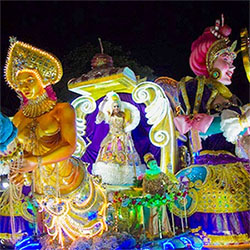 The 22nd annual Festival de la Luz occurred on Saturday, December 16 in San José in the heart of the Christmas season. This has become one of, if not the most, attended parade and festival in Costa Rica. The estimate of those in attendance this year exceeded 1,000,000. That's 20% of the entire country population amigos!
The 22nd annual Festival de la Luz occurred on Saturday, December 16 in San José in the heart of the Christmas season. This has become one of, if not the most, attended parade and festival in Costa Rica. The estimate of those in attendance this year exceeded 1,000,000. That's 20% of the entire country population amigos!
The parade started at 6 PM (sunset here is 5:30 pm +/- 15 minutes all year long) and the festivities continued until midnight, at least the official ones. My guess is that some of the partying went on long after that. Besides the elaborate floats with thousands of lights in the parade there were many masquerades and colorful costumes, live music and fireworks (no decent Tico festival would dare not have fireworks).
Rack up one more successful festival for Costa Rica. There are many each year in this land of happy people.
...and Other Festivals
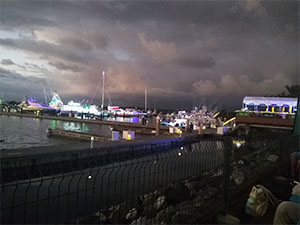 |
| Waiting for Dark and Start of Parade |
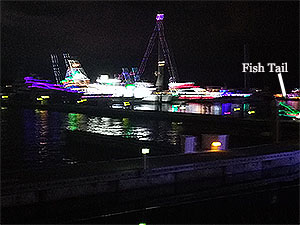 |
| Minutes Before the Parade Started |
December is a busy month and a favorite month in Costa Rica for fiestas. One of the most interesting ones here in Quepos is the Bright Lights Boat Parade which this year took place on December 8 at Marina Pez Vela.
This event started a few years ago (about five I believe) and, if I recall properly, there were a half dozen or so boats the first year and I remember a crowd of around two to three hundred. This fiesta continues to grow each year and this year I counted about 20 yachts in the parade and an ever-increasing elaboration of lighting schemes.
There was music on the bandstand and many types of toy novelties with lights for the kiddies. There were food vendors galore and at least six restaurants based at the marina were open for snacks or full meals, some with a front row seat for the parade.
Some of the boats had literally thousands of lights both static and creating various moving images. One of my favorite was a large, green, lighted fish with a tail that wagged by creative lighting (look very carefully at the lower photo right and you will see the outline of the fish in green - unfortunately someone walked by as I snapped that one and blanked out most of the fish).
The crowd this year by my estimate was over 1,000. Yes, way over said a friend of mine who works at the marina. The official estimate came in at 2,500. The file of cars moving slowly and people walking to the marina supported that. This has become a very popular annual event in Quepos. For another view of this year's parade go to: 2018 Boat Parade YouTube.
 |
| Churros Rellenos |
And then there was the mystery festival. Over a period of a few days it appeared at the new Plaza Bolivar behind the bus station in central Quepos. The first tent to go up and the last to go down was the food tent offering the usual fried chicken, rice with this or that and churros rellenos, that pastry loved so much here. To make churros rellenos you extrude a star shaped hollow dough, deep fry it (of course) and then stuff or coat it with chocolate, caramel or pastry cream. Not exactly low carb but quite yummy. One might call it the Latino version of cannoli.
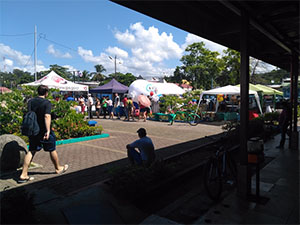 |
| JPS Festival at Plaza Bolivar |
This festival turned out to be run by the JPS or Junta de Protection Civil which is the organization responsible for running the national lottery. The line of people outside the tent in the center (left) ending with the lady with the umbrella protecting herself from the sun was to buy tickets to the biggest lottery of the year, "El Gordo" (the fat one).
El Gordo first prize: 1.6 billion colones or about $2,700,000 but you don't get it all since you buy a number or numbers within a series and a number of people can end up sharing the winnings - don't ask me, it's too complicated. The second prize wasn't bad either, some 160,000,000 colones or about $270,000.
GG won't play a game he doesn't understand so I just got involved with the churros rellenos with a good cup of rich, dark Costa Rican coffee. Yummers.
¡Pura Vida!
Rain, Rain, Go Away
And it did. By early December the rains had abated considerably and, on schedule, by the magic date of December 15, summer had started with only the occasional shower in the afternoon and evening being allowed. This is the time of year when GG reaffirms his beachophile status. The ocean is much calmer yet the water is, of course, always warm, the sun is full much of the time and the beach beckons; who am I to resist?
Pacific Rim Still Quite Active
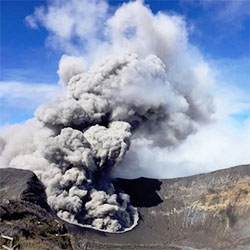 |
| Turrialba Doing Its Thing |
On the rumble side there has been very little let up in volcanic activity. On Saturday, December 10 Volcan Turrialba had a strong eruption and continued to smolder the next day. The very next week on Wednesday the 12th it had another strong eruption sending plumes of ash over the central valley.
Turrialba volcano is only about 35 kilometers or 20 miles east of San José as the ash flies. Prevailing winds from the crater go north to west making the capital city and the airport targets for ash fall. That's exactly what happened on the December 12 as the volcano dropped enough ash on Juan Santamaria airport to cause a two-hour delay for five departing flights and one arrival.
In reviewing the press reports on this, GG found out something interesting. The decision to take off or land in a situation like this is not the airport's but is up to each individual airline. Really? I didn't know that. My instincts tell me I'd be more comfortable with a standard level of critical conditions for safe operation without a direct money influence in the decision mix.
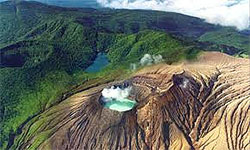 |
| Rincón de la Vieja |
Another press report offered an analysis for the whole of 2018 by the National University’s Volcanology and Seismology Research Institute (OVSICORI - we Ticos love acronyms and abbreviations): 1) Turrialba was the most active with ash emissions on 194 or 58% of days during the analysis period (336 days); 2) Poas was the second most active but largely from degasification and hydrothermal activity when water in the lake meets magma; 3) Rincón de la Vieja and Irazú were active but at a lower level; the report also said that Arenal, Tenorio, Platanar and Barva volcanoes remain dormant.
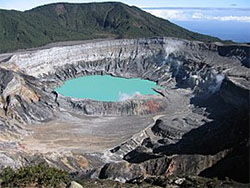 |
| Volcan Poas and Its Lake |
While Turrialba was percolating, another interesting change along the central range occurred. At Volcano Poas (also about 20 air miles form San José but to the northwest) the large lake associated with the volcano changed color from its normal turquoise to a a bright green. This kind of change said one press report has not been seen in almost 200 years.
Explained the volcanologists: “There is a subaquatic fumarole which is very active it injects sulfur dioxide and the visible blue light combines with the yellow of the sulfur and likely this is the result, this particular color”. Dude, it's OK by me but what does the presence of a subaquatic fumarole mean amigo?
Check Out Recent Earthquakes Around the World Posted by the U.S. Geodetic Survey: Recent Quakes |
Search the Golden Gringo Chronicles Archives for Topics That Interest You
You can use our Archives to search for anything that has been written in more than 220 feature articles of the Golden Gringo Chronicles plus find Broken News items and ROMEO restaurant reviews. Enter your topic or item to search in the Google Search Routine below and follow the links offered from the search results. Suggestion: Enter only a simple, precise and unique as possible keyword or two in order to narrow the number of references retrieved:
Readers: Our publication is open to suggestions regarding future articles and will accept pieces written by others but we reserve the right to decline anything that the editorial staff (that's GG) thinks is inappropriate for this format. Send proposals, comments, suggestions, ideas, meaningless statements and jocular observations concerning the Chronicles to GG here: gg@goldengringo.com.
 The idea behind Golden Gringo University is to present educational topics of wide interest to expats who have recently moved to Costa Rica, or to future expats who might be thinking of moving here, or to those who simply visit here frequently. The goal and objective of Golden Gringo University is to provide accurate information that readers will find helpful in their efforts to be a good expat resident or visitor in Costa Rica.
The idea behind Golden Gringo University is to present educational topics of wide interest to expats who have recently moved to Costa Rica, or to future expats who might be thinking of moving here, or to those who simply visit here frequently. The goal and objective of Golden Gringo University is to provide accurate information that readers will find helpful in their efforts to be a good expat resident or visitor in Costa Rica.
For additional GGU topics in past editions go here: GGU Archive.
The information presented here is the best information available at the time of the writing; always check for updates with the appropriate authorities and credible advisers because procedures can and do change frequently.
Definition of a Visa
My handy-dandy online dictionary defines it this way:
" an endorsement issued by an authorized representative of a country and marked in a passport, permitting the passport holder to enter, travel through or reside in that country for a specified amount of time for the purpose of tourism, education, employment, etc."
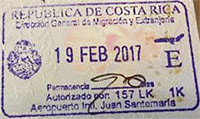 |
| 90-Day Costa Rican Visa Stamp |
In many countries, including Costa Rica, a stamp in the passport constitutes a visa (some countries may require a formal, separate document issued by the visiting country's embassy in the originating country). The photo right is typical for Costa Rica. Note that the amount of time for which the visa is granted has been marked by an immigration clerk in black ink. In most cases, a visitor gets "90" days as shown in the photo.
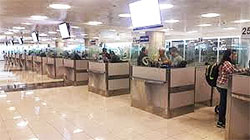 |
| Passport Control Kiosks at SJO |
Rather simple, eh what?
In Costa Rica most people obtain a visa upon entering the country and the airport is the easiest place to do that because they are geared up to handle long streams of people. Both Juan Santamaria airport (SJO) near San José and Daniel Oduber airport (LIR) near Liberia are designated international airports with full customs facilities.
I'm not certain but I would venture the guess that a port for a cruise ship (Puntarenas, Limón) would offer a process similar to an airport. If you come by other means such as by car, bus or foot, you will need to go through a border check point.
The most used border crossings in Costa Rica are Paso Canoas coming north from Panama on the Pacific side and Peñas Blancas in Guanacaste coming south from Nicaragua also on the Pacific Side of the country. Once you've obtained the immigration stamp from any of the authorized points of entry you're good for 90 days.
Respecting the Visa
It can't be overemphasized that it is very important to respect the 90 day limit. Being over the 90 day limit and involved in any infraction of the law can get you deported faster than saying gallo pinto. Even without an infraction you can find yourself in trouble using a passport with an expired visa for those transactions that require a passport, like opening a bank account or other financial transactions.
Watch carefully who you work with on extending your visa or using it during a period of trying to obtain residency. Some seven years ago when GG was in the middle of obtaining his first residency document I was misled by an unknowing and unscrupulous attorney into believing that I could go on indefinitely without having to renew my visa every 90 days because my application for a residency card (cédula) was "in process" (in Spanish: "en tramite"). The last time stamp in my passport was over a year old when the following incident occurred; at that time I had missed at least three renewals.
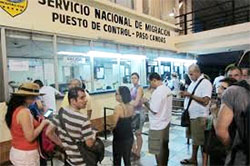 |
| Border Station at Paso Canoas |
Suddenly, after nearly a year and a half of being "en tramite", I was presented by the same attorney with an email that stated that I must leave Costa Rica within three days. I subsequently learned she, the attorney, had failed to provide a couple of documents to immigration despite them sending warnings to her which she never acknowledged to me. As a result my application was summarily rejected.
I immediately scheduled a trip to the Paso Canoas Panama/Costa Rica border to renew my visa. Costa Rica border agents disagreed vehemently with my lawyer's contention of being able to stay in Costa Rica beyond the visa limit while because I was en tramite. I got a visa renewal with difficulty (read the whole ugly story HERE).
I had to start from scratch assembling all new information for my cédula because my old file had been rejected by immigration and sealed; I couldn't use any of the previous documents. Doing it myself with a little help from a trusted Tico translator I accomplished getting new documents and received approval for the cédula in seven months from the earlier rejection date. Obviously I was careful to renew my visa every 90 days during this period (two or three times, I don't remember).
A recent press report noted that there actually is a Costa Rican law on the books right now that says a foreigner can be fined $100 per month for every month the visa period is exceeded. The good news is that this rule has never been enforced but the same report also said there are those calling on the legislature to have this law enforced now.
The lesson in this is of course; always keep your visa renewed until you hold a cédula in your hand. It can take 6 months to a year and a half to get your cédula, which means you will have to go through two to six visa renewals.
For further info on the process for obtaining a cédula, check out the articles HERE. FYI, even cédulas have their own renewal periods depending on the type of residency you get: temporary (2 years) or permanent (5 years).
Physically Negotiating the Border
Getting a new visa at the border stations involves at least four steps (in this order):
Step One: Checking out of Costa Rica. You must get an exit stamp from the Costa Rican immigration border office. Prior to getting in that line you need to pay a $7 exit tax in the same office. You can pay by credit card at a special ATM-like machine or in cash with dollars or colones. You must get the receipt before you get the stamp.
Step Two: Checking into Nicaragua or Panama. Similarly to #1, except here you will pay an entry tax of $3 for Panama and $12 for Nicaragua payable by card or local currency (colones). You will then get an entry stamp like the Costa Rican visa.
Step Three: When you're ready, you reverse the process by checking out with another stamp from either Nicaragua ($3 exit fee) or Panama ($3 exit fee).
Step Four: You check into Costa Rica in the same place where you checked out, getting a new stamp with your 90 day visa. There is no entry fee for Costa Rica but a valid ticket receipt is necessary showing your plan to leave the country within the visa period (see "Renewing the Visa" below).
Renewing the Visa
Of course, if you take a flight back home or to another country before your 90 days is up your visa will automatically be renewed on your return.
A new twist in the regulations was added during my early period here mentioned above. It requires someone getting a tourist visa to present a ticket receipt (or ticket) that shows you leaving the country sometime within the 90 day visa period. At that time the rule held for both Costa Rica and Panama immigration authorities. On my first encounter with this rule GG was able to buy two bus tickets at the Panama/Costa Rican border, one for exiting Panama after I had entered there and the other, to satisfy Costa Rican entry, as a ticket back to Panama to cover the stipulation for the 90-day CR visa. Total cost for both tickets: $30.
I'm told that others have gotten around this rule by buying a refundable airline ticket and canceling it later (caution - forgetting to cancel a refundable ticket or buying a non-refundable ticket can be quite expensive).
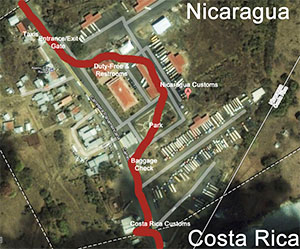 |
| Peñas Blancas Border Crossing |
As mentioned above, the most common places to renew your passport visa if you are living in Costa Rica on the Pacific Coast are 1) the Paso Canoas border crossing with Panama which is about two and a half hours by car (a little more by directo bus) down the coastal highway south from Quepos and 2) the Peñas Blancas border crossing with Nicaragua about 4-5 hours north of Quepos by car (and about 7 hours by three different buses: Quepos to Puntarenas to Liberia to Peñas Blancas).
N.B. I'm told that you will not be allowed to exit the country in a rental car so you will be required to make arrangements to store the car at the border until you return or use another means of transportation.
The first few times I renewed my visa GG used the opportunities to visit other countries. Twice I went to Nicaragua and took in San Juan del Sur, a picturesque little harbor and beach town only about 30 miles north of the Costa Rican border. Another time I went to Granada about 60 miles north of the Nica/CR border, an historic city with a long Spanish tradition and the architecture to prove it. Yet another time I took advantage of a four-day special fare to San Andres Island, a Colombian island in the Caribbean which sits atop an atoll surrounded by crystal clear water and is located just off the Nicaraguan east coast (45 minute flight from San José).
So don't forget, you can make fun and adventure a part of your visa renewal plan.
¡Solo Bueno!
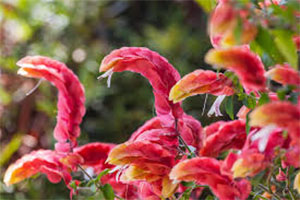
Is it a Furry Red Attack Worm?
Or an Overly-Fertilized Hibiscus?
Answer in What's-in-a-Word section below.
¡Solo Bueno!
GG wrote an article recently for an international travel magazine about my experience living in Quepos. After ten years residency here I found it very easy to describe how much I like it here and why. I'm reprinting the entire article below for you to critique:
Rediscovering the Simple Life in Quepos
by Bob Normand
During my 75 years on this planet I have lived in five U.S. States and three countries on two continents, and for the past ten years as an expat resident in Quepos, a small town on the Central Pacific Coast of Costa Rica. I can truly say I have never enjoyed living in a place more than I have here.
The town of Quepos is about 10,000 people and the entire cantón or county is only about 30,000. The population is augmented substantially during the winter months (January to May, our summer) by tourists and semi-permanent owners and renters (part-timers and snowbirds). Many expats who have not taken the full plunge return to Quepos and its surroundings year after year before making a commitment to permanent residency here.
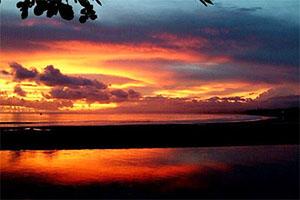 |
| Sunset from the Malecón |
Quepos is a relatively young town, having been originally constructed in the 1940’s by the Compania Bananera (the Banana Company, an early company later acquired by Chiquita). The company built the town virtually out of nothing so that their employees would have better opportunities for products and services, something that a town attracts and its residents need.
To build the town, a dyke was built across a swamp between two coastal mountains and the swamp filled in. This is why the streets in Quepos are flat and follow a grid pattern of north-south/east-west much like New York City rather than being curvy and hilly like many Costa Rican towns. The dyke, known as the Malecón, is now a very pleasant river-walk park overlooking the Pacific Ocean and its incredible sunsets. It’s also the scene of several town fiestas during the year.
But what I love most about this town is the attitude of the people. They’re quick to make friends and enjoy being of help when they can. Walking through Quepos brings on a continuous chorus of "Buenos Dias" (“Good Morning”) or "Como le va?" (How's it going) or “Solo Bueno!” (Only Good!) and, of course, the famous “Pura Vida!” (don’t ask, there are several interpretations of this singularly Tico phrase, all positive).
Once I tripped over a speed bump walking home, fell and scraped both elbows and a knee. Two ladies in their fifties came running out of the nearest house yelling “Oh, Señor!”. They took me in, cleaned the scrapes and treated it with a magic red fluid called Sterop Lisan which gave my wounds a quick heal (I’ve since kept a bottle in my own medicine cabinet). I went back later with some candy and flowers to thank them and to cement our relationship. I think this story tells more about the Costa Rican character than anything else.
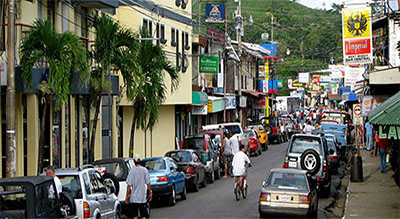 |
| Main Street - Downtown Quepos |
Because Quepos is so compact downtown, essentially five by five blocks, I walk everywhere yet often overestimate the amount of time needed to get things done.
Recently I left my home at about 9 AM and walked three blocks south to the post office to mail a letter and check my box, then two blocks west to see my barber, a fellow even older than me, who was the first barber in Quepos. Then I walked one block east to the bank to pick up some cash, then two blocks to the Mercado (fresh market) where I bought farm fresh vegetables, then to the supermarket for some groceries and then home. I was home by 10:30 without rushing.
Notice that I said walked to all these places. When I moved here in 2008 I sold my car in Florida and after 50 years of continuous car ownership, decided to try living here without one for three months. I have never felt the need to get a car. Local buses are free to senior residents and long hauls are offered at 25% discount. Once or twice a year I feel a need for one reason or another to rent a car. I love handing the rental car back to the agency and not having to regularly spend for gas and maintenance.
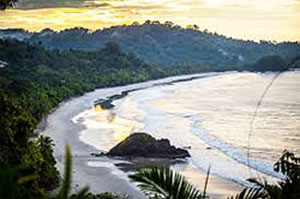 |
| Playa Espadilla (Main Beach) at Dawn |
The day I did the walkabout mentioned above I later changed into my beach togs, doubled back to the bus station and picked up a bus to Manuel Antonio beach (they run every 15 minutes and take about twenty minutes to reach the beach from the Quepos station). I spent a couple of hours in a chaise lounge under an umbrella (3,000 colones or about $5 for all day if you want) chatting with vendors and beach helpers I know and also reading a book. I then had lunch at a little restaurant just off the beach. I was home and showered in time for my 4:30 nap (ah, the schedule of a retired expat in Quepos can be rigorous).
It can be difficult choosing a restaurant for lunch or dinner here only because there are so many to choose from. My guesstimate is that between Quepos and its contiguous sister village of Manuel Antonio there are more than five dozen restaurants to choose from. The offerings range from simple Costa Rican fare in small restaurants called “sodas” to internationally eclectic gourmet offerings at the Quepos Marina and along Manuel Antonio road. And there are many more average eateries of a level in between these. For gastronomical fun and pleasure we have a ROMEO Group (Retired Old Men Eating Out) that reviews a different restaurant each month.
But retirement is not just about relaxation, although that’s important. Most people who have been active like me throughout their careers will want and need something more productive to make use of their extra time in retirement. Many people I know here have gotten involved in community improvement projects, environmental programs or animal rescue and recovery efforts.
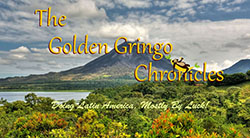 |
| The Golden Gringo Chronicles |
For my part I turned to writing. I started by sending monthly emails back to my kids and friends in the States. Slowly but surely the monthly writing took on a consistent format and turned into a newsletter called the Golden Gringo Chronicles. Golden because of my “golden years” and also because I was lucky enough, i.e., “golden”, to have found my retirement paradise in Costa Rica. I’ve also penned two books about Costa Rica and am working on a third.
I now spend anywhere from ten to twenty hours per week writing the Chronicles and just finished the 123rd edition. I’m happy to report that writing the Chronicles has more than paid me back because the effort required to research various topics I write about made me learn about Costa Rica much faster than I would have otherwise.
Yes, in Quepos I have rediscovered the simple lifestyle.
Nuff said.
¡Solo Bueno!
| Note: The information given in this section is offered as news information only and does not indicate GGC confirmation or denial of the accuracy of the treatment or a recommendation to pursue it, nor can we or do we guarantee the efficacy of the results nor validity of the conclusions proffered. (How's that for a disclaimer amigos?) |
Inquiring Minds Want to Know
 GG was saddened recently by the death of his sister at age 83 after twelve years of battling Alzheimer's. Anita was a sister eight years older than myself who was a close friend in my formative years and sometimes a protector in elementary school and junior high before she got married and had a family of her own (five children).
GG was saddened recently by the death of his sister at age 83 after twelve years of battling Alzheimer's. Anita was a sister eight years older than myself who was a close friend in my formative years and sometimes a protector in elementary school and junior high before she got married and had a family of her own (five children).
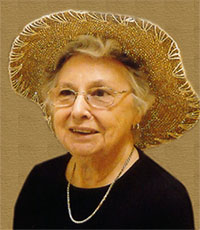 |
| Anita Normand Langlais |
Unfortunately Anita was not the only family victim of this disease as my brother Eddie also succumbed to Alzheimer's in 1994 at a much younger age. So you can see I have more than a passing interest, more like a good chance of personal susceptibility to, what this disease is and how it might be prevented.
Many researchers are now laying the disease at the foot of bad diets or at least suggesting that succumbing to the disease earlier is thus related. A friend recently gave me a book called "Grain Brain" by David Perlmutter. M.D.; "The Surprising Truth About Wheat, Carbs and Sugar - Your Brain's Silent Killers". I'll be digging into that one shortly, as soon as I finish two other must reads in the cue that have nothing to do with diet.
A quick Internet survey found a thing called the MIND Diet (MIND stands for Mediterranean-DASH Intervention for Neurodegenerative Delay). OK, whatever. It looks a lot like the Mediterranean diet in that it recommends large quantities of green leafy and other vegetables (not enough in my diet), nuts (eat plenty of these, I love them), berries (particularly blue berries - I love cranberries), beans (I've been in love with gallo pinto since I've been in Costa Rica but I could lighten up on the rice), whole grains (how do you tell what's whole?), fish (love it), poultry (chicken and turkey are A-OK with me), olive oil (no problem - always cook with it), wine (1 glass per day - sorry that one's off the list for me).
 The five no-no food groups are, according to the MIND diet: 1. red meat (I eat very little now), 2. butter and stick margarine (I use a moderate amount of butter), 3. cheese (aw, c'mon), 4. pastries and sweets (I throw myself on the mercy of the court), fried foods and fast foods (agreed and not a fan anyway, churros rellenos being an exception).
The five no-no food groups are, according to the MIND diet: 1. red meat (I eat very little now), 2. butter and stick margarine (I use a moderate amount of butter), 3. cheese (aw, c'mon), 4. pastries and sweets (I throw myself on the mercy of the court), fried foods and fast foods (agreed and not a fan anyway, churros rellenos being an exception).
Having read the Atkins book back at the turn of the millennium, which simply concentrates on limiting carbohydrates, which both MIND and Gran Brain also suggest, it will be interesting to see what else in these three systems converge to suggest a diet for both general good health and avoidance/delay of things like Alzheimer's.
I'll keep readers apprised of progress and will appreciate any poignant and pithy comments you'd like to make along the way. I'm sure that other inquiring minds want to know also.

¡Solo Bueno!
 GGC Publications Group is the parent organization that publishes the Golden Gringo Chronicles as well as a number of books and paraphernalia related to the Chronicles and Costa Rica. The GGC Bookshelf also includes works from a number of other authors that belong to the Quepos-Manuel Antonio Writers Group in which GGC has been a founding member.
GGC Publications Group is the parent organization that publishes the Golden Gringo Chronicles as well as a number of books and paraphernalia related to the Chronicles and Costa Rica. The GGC Bookshelf also includes works from a number of other authors that belong to the Quepos-Manuel Antonio Writers Group in which GGC has been a founding member.
Here are the books currently on our bookshelf:
 |
 |
 |
 |
| The Chronicles as a Narrative | Mariposa - English | Mariposa - Español | Small Business Guide |
| Read More | Read More | Leer más aquí | Read More |
 |
 |
 |
 |
| Overcoming Drinking | Making Time Count | Spiritual Love Connection | Murder or Suicide? |
| Read More | Read More | Read More | Read More |
 |
 |
 |
There's Room for More on the QMA Writers Group Bookshelf |
| Getting Around the Capital | Retiring in Costa Rica | World War II True Story | |
| Read More | Read More | Read More |
All of the above books are available on Amazon.com and the "Read More" links above will lead you to them. You can find more detail on all of them on our GGC Publications Page.
GGC Publications also offers some accessories and paraphernalia related to the Chronicles and with Costa Rican themes, to wit
T-Shirts:

a. Golden Gringo Chronicles with Logo,
b. Official Golden Gringo with Monkey on Banana Hammock,
c. ¡Quepo en Quepos! ("I Fit In Quepos!") with Photo of Quepos,
d. Wanna Monkey Around? - Come on Down! with Photo of White Face Monkey,
e. It's OK to be Slothful with photo of Three-Toed Sloth.
The t-shirts are available in several colors, styles and sizes. See them all HERE.
Coffee Mugs:
a. Golden Gringo, b. Wanna Monkey Around?, c. It's OK to be Slothful
What's life without a great cup of Costa Rican coffee? And it tastes even better in a Golden Gringo Chronicles mug!
Answer to Que Es Eso?
 |
| Lollipop Plant |
It's a shrimp plant (Pachystachys lutea), native to Peru but common in Costa Rica and many tropical areas. The cone-like flowers shoot out from a shrub that grows 2-6 feet tall and they in turn produce small white flowerets in random positions. Shrimp plants come in red and yellow versions and the yellow version is also often called a lollipop plant.
Why is it called a shrimp plant asked GG? The only thing I could find on that, said this: "...the bracts somewhat resemble the overlapping scales on a shrimp". That seems like a stretch to me but the nickname has stuck anyway. Lollipop Plant? Seems like an even greater stretch.
They sure are beautiful though.
Agua Azul, Manuel Antonio
Location: Top of Manuel Antonio hill on the main road towards the beach about 25 meters from the Promerica Shopping Plaza
Hours: 11 AM to 10 PM, Closed Wednesdays, Reservations NOT Accepted
Parking: Seems adequate directly in front for the size of the restaurant.
Contacts: Tel.: 2777-5280; Email: N/A; Website: http://www.cafeaguaazul.com
Reviewing ROMEOS: Alma L. Bob N., Charlotte H., Jeanette P.
To Review Our Rating System Go Here: R.O.M.E.O. Rating System
The last time we reviewed the Agua Azul was in March of 2013 - see that review HERE. We tried to update our review about a year ago but were turned away as the restaurant was full - they take no reservations and it was crowded at dinner time. This time we came for lunch.
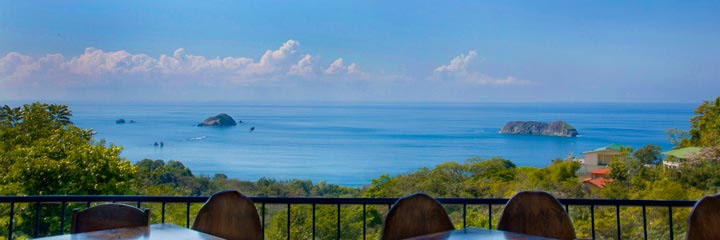 |
| View from the Dining Room at Agua Azul - Los Gemelas (Twins) Lower Left Foreground and Elephant Island Right |
This is not a large restaurant, probably having a seating capacity of less than 30.
The dining room is furnished with typical heavy wooden chairs and tables seen around this area with no adornments on the tables. The chief contribution to ambiance here is the outstanding view of the Pacific and the islands just off Playa Espadilla in Manuel Antonio. That view is shared with only a half dozen or so other restaurants along the ridge at the top of Manuel Antonio. The composite score for ambiance came in at 4.4/5.0 sloths.
We were presented with a large, one page menu which had a good mixture of appetizers, salads, assorted wraps, a few pastas and some chicken and beef dishes. Of course one needs to remember that Agua Azul is the undisputed home of large burgers for those that want to renew their gringo heritage. The menu still sports 1/2 lb, 1 lb and 2 lb versions for the less than faint of heart.
GG was intrigued by an item under salads - a Caesar with plantains. Rather than ask what that meant I ordered it and, while it was being prepared, conjured up all kinds of possible treatments that could have been applied to the plantains. What was delivered was a simple shredding of something that approached romaine lettuce bathed in a bottled Caesar dressing. A good basic lunch but somewhat disappointing in its execution.
Two other ROMEOs ordered wraps, one a buffalo chicken and another a veggie and rated them fairly high on their freshness and taste. Another ROMEO had a very brightly colored spring roll which won the presentation award at least.
The composite score for food quality came in at 3.8/5.0. |
 |
|---|---|
| $$$.5 | |
Value Index= 114 |
We were served by a young Quepoan lad who was very friendly, polite and attentive. The composite score for service was 4.0/5.0. That gave an average score for ambiance, food quality and service of 4.0/5.0.
For my salad and a batido of mixed sandia and papaya in water, the bill came to about 6,900 colones (currently about $11.50). The composite score from the group for cost was 3.5/5.0 yielding a Value Index of 4.0/3.5x 100=115.
Agua Azul continues to present an option for a pleasant meal at a reasonable price while taking in an extraordinary view of paradise from the top of Manuel Antonio hill.
¡Solo Bueno!
The Golden Gringo Chronicles is a free newsletter that is non-political, non-commercial and, hopefully, entertaining. By signing up you will receive an email each month around the first of the month giving you the links to the latest edition as well as to each individual feature and departmental section.
CLICK HERE TO SIGN-UP FOR THE GOLDEN GRINGO CHRONICLES
or Email me at gg@goldengringo.com, or use our Website at: www.goldengringo.com

Bob Normand, Editor
& The Golden Gringo
Pura Vida!
To Contact GGC World Headquarters (yuk, yuk) to make comments, suggest topics or criticize my bad jokes, just send an email to: gg@goldengringo.com.
Be pithy but kind; I'm sensitive.
Unsubscribe from Golden Gringo Chronicles